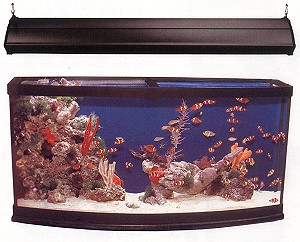Filtering Aquarium Water

For aquatic animals, good water quality is synonymous with good health. Good water quality is dependent on efficient filtration of the water in your tank. Understanding filtration is one of the most difficult tasks facing the new aquariust.
Even the novice aquarist is aware that high levels of ammonia will quickly spell the end to her fish. Unfortunately, many water quality problems are more subtle. There is a domino effect set in motion with deteriorating water quality, ending in the death of a tank full of pets.
As water quality slowly worsens, the fish suffer from physical stress. Stress, over time, will cause the health of the fish to decline. Chronic stress makes fish vulnerable to bacterial and fungal infections and parasitic infestations. These infections and infestations will be but the conclusion to the phenomenon that began with poor water quality caused by inadequate filtration.
An appropriate filtration system and good aquarium management can minimize, if not completely eliminate, chronic stress. To better illustrate the correlation between fish health and filtration, a discussion of the three basic types of pollutants that accumulate in aquarium water and the corresponding filter options for each kind is appropriate.
Biological Pollutants
Biological filtration works to eliminate the presence of ammonia and nitrite in the aquarium water. Ammonia and nitrite probably account for more health problems and deaths with aquarium fish than any other cause. The fish excretes directly through the gills approximately 60 percent of the ammonia in an aquarium. The remainder is produced by bacterial breakdown of fish feces and urine, uneaten food, dead animals and plant byproducts. Nitrite is a waste product of the bacteria that use the ammonia for food.
The accepted theory is that ammonia in aquarium water hinders oxygen uptake in the fish's blood. Lethal concentrations cause chronic stress. Gill filaments become irritated and begin to swell. This cuts off the oxygen supply to the membrane cells, when they become infected with bacteria. Ammonia-related stress also lowers a fish's resistance to parasite and bacteria attacks, reduces food intake, and can result in death. An ammonia test kit measures total ammonia, which in a well-managed aquarium should be immeasurable. All aquarists should have an ammonia test kit and use it on a regular basis.
Likewise, Nitrite toxicity involves blocking oxygen uptake in the blood. As nitrite levels increase, the concentration of methemoglobin (as a percentage of total hemoglobin) goes up, reducing the capacity of the blood to carry oxygen. Sub-lethal concentrations produce chronic stress similar to ammonia. Here again, regular use of a nitrite test kit is an absolute requirement for a fishkeeper. There are two basic solutions to this problem: ion exchange and biological filtration.
Ion exchange is a chemical filtration process that removes ionized ammonia (NH4+) from the water by swapping it for an ion in the exchange medium. Both natural zeolites (which look like little chips of cement) and synthetic resins (which look like little plastic beads or chips) are used to remove ammonia from aquarium water. Ion-exchange resins (but not zeolites) also remove nitrites and nitrates.
The exchange medium is placed in a compartment of an outside filter (after the compartment with GAC so that the water flows through the GAC first) and aquarium water is forced through it. Ion-exchange media can only be used in freshwater tanks. This also precludes the use of salt in freshwater tanks for medicinal purposes when using ion exchange. Ammonia ion exchange is also severely inhibited in hard water. Even moderate levels of DOC in the water significantly reduce ammonia ion exchange. Thus, the use of zeolites or ion exchange resins requires continuous filtration of particulates and DOCs.
When ion-exchange material becomes saturated with ammonia, it must be recharged or replaced. Otherwise, the ammonia concentration will quickly build up to dangerous levels (known as ammonia break-through). Therefore, the use of ion-exchange media requires regular and frequent ammonia testing.
An alternative approach is biological filtration, a method that uses naturally occurring nitrifying bacteria to detoxify nitrogenous wastes. One type of bacteria converts ammonia to nitrite. These bacteria are usually well established in aquarium gravel, on tank walls and on plant surfaces within two weeks of adding fish to a new setup.
Another naturally occurring bacteria converts the nitrite into a far less harmful form of nitrogen waste: nitrate. Laboratory studies have shown that nitrates are far less harmful to fish than once believed. Concentrations in excess of 400 mg/L appear safe for fish. (Nitrates are more toxic to marine invertebrates.)
Although all aquariums have some amount of natural biological filtration occurring on the surface of the gravel bed, it is usually far too little to handle the fish load. A dedicated biological filter is significantly more effective. There are two basic designs: the undergravel filter and the wet dry filter.